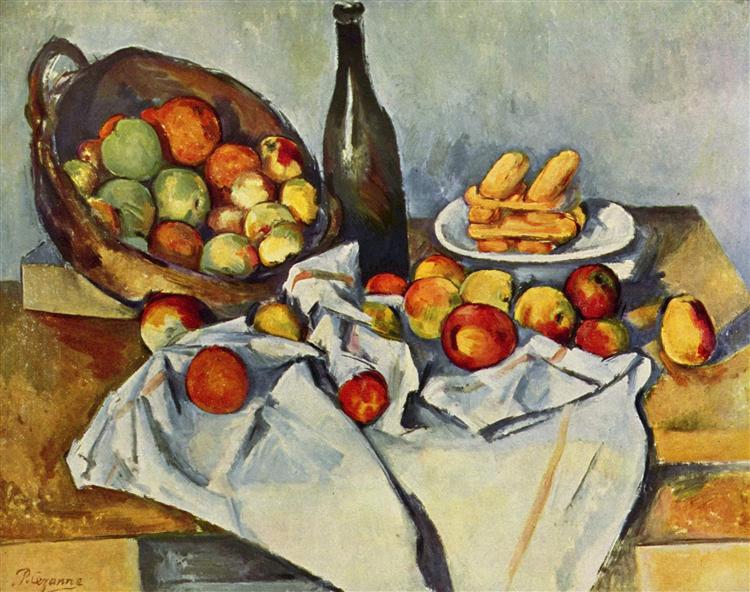Description
Paul Cézanne's Basket of Apples (1895) is a brilliant testament to the artist's mastery and innovative approach to still life. In this painting, Cézanne delves into the depiction of everyday objects, such as apples and a bottle, while simultaneously attempting to break down and reconstruct the visual perception of the real world. This groundbreaking approach lays the foundation for his contribution to modernism and his influence on later generations of artists.
From the first glance, what stands out in the composition is the arrangement of the elements. The apples, in bright red and yellow hues, occupy a central place, creating a contrast with the darker-toned table. The basket, whose shapes are suggested in a somewhat abstract way, becomes an organic part of the whole, inviting the viewer to explore its volume and almost tactile texture. Cézanne uses geometry as a starting point; the spherical shapes of the apples are balanced by the cylindrical structure of the bottle and box in which they are housed. Through this use of solid forms, Cézanne established a dialogue between the natural and the structured, a characteristic that distinguishes his style.
The color in “Basket of Apples” is another of the great qualities of this work. Cézanne employs a rich and nuanced palette, with tones varying from warm reds and oranges to darker, earthier hues. Through the application of paint, he shows a deep understanding of light and its effect on objects. Shadows, often rendered in blues and greens, not only serve to anchor the objects to the surface, but add a painterly dynamism that breathes life into the whole.
Beyond the inanimate elements, it is notable how this work does not include any human figures. Instead, Cézanne manages to convey a sense of existence and life through the inanimate objects. This omission speaks to his interest in the everyday and what might be considered trivial, challenging the notion that greatness in art lies only in the depiction of historical or mythological subjects. By focusing his attention on domestic items, he invites the viewer to reflect on the meaning in the simple.
The painting presents a visual balance that guides the viewer throughout the work. Through the apples and the bottle, Cézanne plays with perspective, creating subtle challenges for the observer's eye. The angles and inclinations invite us to reinterpret what is known and familiar. This way of breaking with the traditional rules of art has been interpreted as a precursor to movements that would come later, moving into abstraction.
In terms of his historical context, Cézanne is in the transition to what is known as Post-Impressionism, a movement that seeks to go beyond the capture of light and color of Impressionism, offering instead a new way of seeing reality. His “Basket of Apples” is emblematic of this period, evidencing the search for a deeper and more structural interpretation of objects.
In conclusion, “Basket of Apples” is not only a visual representation of a simple set of fruits and a bottle, but through its color, shape and composition, it implies a deeper reflection on perception, reality and the idea of the everyday. Paul Cézanne, through this work, invites us to question our own perceptions, making this still life a key piece in the evolution of modern art. Its influence lives on, resonating in the works of many artists who followed him, who found in Cézanne a beacon of innovation and exploration.
KUADROS ©, a famous painting on your wall.
Hand-made oil painting reproductions, with the quality of professional artists and the distinctive seal of KUADROS ©.
Painting reproduction service with satisfaction guarantee. If you are not completely satisfied with the replica of your painting, we will refund 100% of your money.

